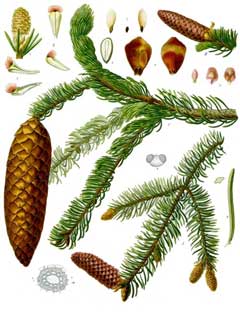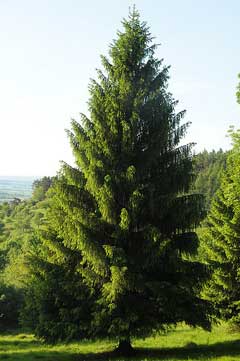 |
|
http://commons.wikimedia.org/wiki/File:Koeh-105.jpg |
 |
| http://commons.wikimedia.org/wiki/User:UnreifeKirsche |
Translate this page:
Summary
Bloom Color: Pink. Form: Pyramidal.
Physical Characteristics

 picea abies is an evergreen Tree growing to 30 m (98ft) by 10 m (32ft) at a fast rate.
picea abies is an evergreen Tree growing to 30 m (98ft) by 10 m (32ft) at a fast rate.
See above for USDA hardiness. It is hardy to UK zone 4 and is not frost tender. It is in leaf all year, in flower from May to June, and the seeds ripen from October to November. The species is monoecious (individual flowers are either male or female, but both sexes can be found on the same plant) and is pollinated by Wind.
It is noted for attracting wildlife.
Suitable for: light (sandy), medium (loamy) and heavy (clay) soils and can grow in nutritionally poor soil. Suitable pH: mildly acid and neutral soils and can grow in very acid soils.
It cannot grow in the shade. It prefers moist or wet soil. The plant can tolerate maritime exposure.
It cannot tolerate atmospheric pollution.
UK Hardiness Map
US Hardiness Map
Synonyms
P. excelsa. Abies picea. Pinus abies.
Plant Habitats
Woodland Garden Canopy; Ground Cover; Bog Garden;
Edible Uses
Edible Parts: Flowers Inner bark Seed Shoots
Edible Uses: Tea
Young male catkins - raw or cooked. Used as a flavouring[172]. Immature female cones - cooked. The central portion, when roasted, is sweet and syrupy[172]. Inner bark - dried, ground into a powder and used as a thickener in soups etc or added to cereals when making bread[172]. An emergency food, used when all else fails. Seed - raw. Rich in oil and with a pleasant slightly resinous flavour, but too small and fiddly to be worthwhile unless you are desperate[172]. A refreshing tea, rich in vitamin C, can be made from the young shoot tips[172]. These tips are also used in making spruce beer[183].
References More on Edible Uses
Medicinal Uses
Plants For A Future can not take any responsibility for any adverse effects from the use of plants. Always seek advice from a professional before using a plant medicinally.
Antibiotic Antiseptic Balsamic Expectorant Poultice Sedative Vitamin C
The buds, leaves and resin are antibiotic, antiseptic, balsamic, expectorant, sedative[7]. A pitch, or resin, obtained from the trunk is rubefacient and stimulant[240]. It is used externally in plasters etc for its healing and antiseptic properties[7]. A poultice of the sap or gum has been used in the treatment of boil and abscess pain[257].
References More on Medicinal Uses
The Bookshop: Edible Plant Books
Our Latest books on Perennial Plants For Food Forests and Permaculture Gardens in paperback or digital formats.

Edible Tropical Plants
Food Forest Plants for Hotter Conditions: 250+ Plants For Tropical Food Forests & Permaculture Gardens.
More

Edible Temperate Plants
Plants for Your Food Forest: 500 Plants for Temperate Food Forests & Permaculture Gardens.
More

More Books
PFAF have eight books available in paperback and digital formats. Browse the shop for more information.
Shop Now
Other Uses
Adhesive Essential Pitch Shelterbelt Tannin Varnish Wood
The tree is a source of pitch (Burgundy pitch) and turpentine (Jura turpentine)[1, 7, 46, 64]. Burgundy pitch is used as a varnish and in medicinal plasters[57]. It is a strong adhesive[61, 64]. The turpentine is a waterproofer and wood preservative. They are obtained by incisions in the trunk, the resin is scraped out some months later[64]. An essential oil from the leaves is used in perfumery[46, 61]. The seed contains 30% of a fatty oil, this is used in the production of a varnish[74]. The bark contains some tannin[171]. Both the bark and bark extract have been widely used in Europe as a source of tannin, the bark containing up to 13% tannin[223]. Yields of tannin have been doubled by heating or steaming the bark as soon as possible after the tree has been felled[223]. A fairly wind resistant tree and fast growing, it can be planted in shelterbelts to provide protection from the wind[200]. The dwarf cultivar 'Inversa' can be grown as a ground cover plant in a sunny position[188]. The cultivars 'Reflexa' and 'Procumbens' can also be used[208]. They are best spaced about 1 metre apart each way[208]. Wood - medium hard, fairly elastic, durable under water, light in weight and colour. Used for general carpentry, joinery, musical instruments etc. Valued for its use in the pulp industry to make paper[1, 11, 13, 46, 66].
Special Uses
Attracts Wildlife Food Forest Ground cover Scented Plants
References More on Other Uses
Cultivation details
Landscape Uses:Firewood, Screen, Specimen. Likes abundant moisture at the roots, if grown in drier areas it must be given a deep moist soil[11]. Succeeds in most soils including those that are wet cold and shallow, but it is not very wind-firm in shallow soils[1]. Intolerant of chalky or poor acid soils[11]. Tolerates poor peaty soils[200]. Prefers a pH between 4 to 6[200]. Dislikes shade[200] according to one report whilst another says that it is moderately shade tolerant[125]. Intolerant of atmospheric pollution[11]. Resists wind exposure to some degree and is tolerant of saline winds[200]. A very cold-hardy tree when fully dormant, though the young shoots are subject to injury by late frosts[1], though less so than P. sitchensis[125]. A fast growing tree, it is widely planted in cool temperate zones for its wood[200]. Young trees often grow 1 metre or more a year and can sustain an average of 60cm for at least the first 60 years though growth tails off as they grow older[185]. Probably not that long-lived in Britain, about 200 years seems the absolute maximum[185]. In some upland areas, especially over granitic or other base-poor soils, growth rate and health have been seriously affected by aluminium poisoning induced by 'acid rain' pollution[200]. There are many named varieties, almost all of them dwarf forms[200]. A food plant for many caterpillars[30]. A very aggressive tree, it is hostile to other trees[18]. Susceptible to attacks by bark beetles so it should be kept away from more valuable trees. A biological control is being introduced (1983)[125]. This species is susceptible to honey fungus[81]. Trees should be planted into their permanent positions when they are quite small, between 30 and 90cm. Larger trees will check badly and hardly put on any growth for several years. This also badly affects root development and wind resistance[200]. Plants are strongly outbreeding, self-fertilized seed usually grows poorly[200]. They hybridize freely with other members of this genus[200]. The seed is shed in spring[1], the cones release their seed whilst they are still on the tree[81]. The bruised leaves emit a delicious musky smell[245]. Special Features:
Not North American native, Inconspicuous flowers or blooms.
References Carbon Farming Information and Carbon Sequestration Information
Temperature Converter
Type a value in the Celsius field to convert the value to Fahrenheit:
Fahrenheit:
The PFAF Bookshop
Plants For A Future have a number of books available in paperback and digital form. Book titles include Edible Plants, Edible Perennials, Edible Trees,Edible Shrubs, Woodland Gardening, and Temperate Food Forest Plants. Our new book is Food Forest Plants For Hotter Conditions (Tropical and Sub-Tropical).
Shop Now
Plant Propagation
Seed - stratification will probably improve germination so sow fresh seed in the autumn in a cold frame if possible[80]. Sow stored seed as early in the year as possible in a cold frame[78]. A position in light shade is probably best[78]. Seed should not be allowed to dry out and should be stored in a cool place[80]. Prick out the seedlings into individual pots when they are large enough to handle and grow them on in the greenhouse or cold frame for their first winter. They can be planted out into their permanent positions in early summer of the following year, or be placed in an outdoor nursery bed for a year or so to increase in size. They might need protection from spring frosts. Cuttings of semi-ripe terminal shoots, 5 - 8cm long, August in a frame. Protect from frost. Forms roots in the spring[78]. Cuttings of mature terminal shoots, 5 - 10cm long, September/October in a cold frame. Takes 12 months[78]. Cuttings of soft to semi-ripe wood, early summer in a frame. Slow but sure.
Other Names
If available other names are mentioned here
Native Range
EUROPE: Finland, Norway, Sweden, Austria, Switzerland, Czech Republic, Germany, Hungary, Poland, Slovakia, Russian Federation (European part), Belarus, Estonia, Lithuania, Latvia, Ukraine, Albania, Bulgaria, Bosnia and Herzegovina, Greece, Croatia, Italy, North Macedonia, Montenegro, Romania, Serbia, Slovenia, France
Weed Potential
Right plant wrong place. We are currently updating this section.
Please note that a plant may be invasive in one area but may not in your area so it's worth checking.
Conservation Status
IUCN Red List of Threatened Plants Status :

Growth: S = slow M = medium F = fast. Soil: L = light (sandy) M = medium H = heavy (clay). pH: A = acid N = neutral B = basic (alkaline). Shade: F = full shade S = semi-shade N = no shade. Moisture: D = dry M = Moist We = wet Wa = water.
Now available:
Food Forest Plants for Mediterranean Conditions
350+ Perennial Plants For Mediterranean and Drier Food Forests and Permaculture Gardens.
[Paperback and eBook]
This is the third in Plants For A Future's series of plant guides for food forests tailored to
specific climate zones. Following volumes on temperate and tropical ecosystems, this book focuses
on species suited to Mediterranean conditions—regions with hot, dry summers and cool, wet winters,
often facing the added challenge of climate change.
Read More
Expert comment
Author
(L.)H.Karst.
Botanical References
11200
Links / References
For a list of references used on this page please go here
Readers comment